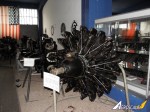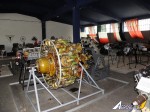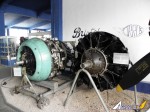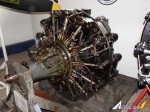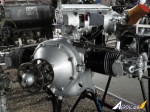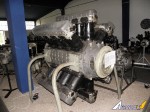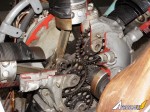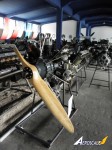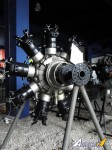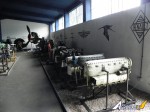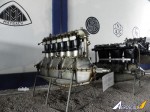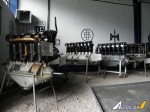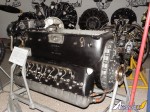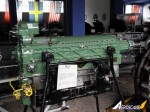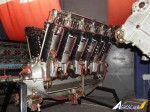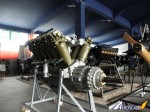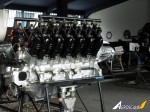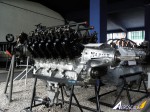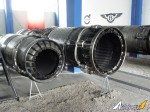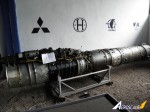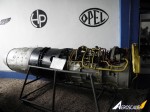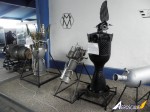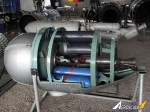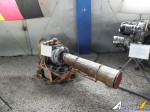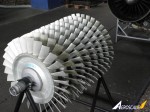Polish Aviation Museum, Kraków - Part 4
...
Post a Comment
In one of the buildings behind the big hangar you can find a small door between the AA missiles and mobile radar stations. There's a walkway leading to these door. Inside this building you get to another exhibition of the aviation engines. The display is really impressive, there are about 100 different engines varied from the early XX century construction to the jet and rocket engines. Some engines are also displayed in other buildings of the complex but these are not more than 10. So we have at least 90 different engines gathered in one place. A very specific and distinctive feature of this display, which I can't even describe, is the smell of oil and steel. I bet you know what I'm talking about.
Close to the entrance, on the left hand side, you can find a very interesting display of the early German six and eight cylinders in-line motors like Austro-Daimler DM 200, BMW IIIa, Maybach MB 4, Mercedes DIII and DIV's, Mercedes E4F and many other.
Another row worth closer attention is the display of the pre-ww2 PZInż motors: cutaway of the Junior, Major Type 4, Pegaz 20 (currently on display in the Main Building), Pegaz II M 2, Pegaz VII, Pegaz VIII. “Pegaz” is a Polish word for “Pegasus”, so these motors are licensed built Bristols.
A separate hall is dedicated to the jet and rocket engines. We can find here both luggage-size rocket engines and the jet engines in the size of a small bus. There is for example the Russian AI-25, used on Yak-40 or L-39 Albatroses, WK-1A (Mig-15bis), TG-16, RD-9B (Mig-19S), RD-500 (Yak-23, Ła-15), RD-10A (Yak-15, Yak-17, Ła-152).
Unfortunately for the photographers there is very difficult illumination on this display. Small and highly located windows do not give enough light in all places. You will have to prepare yourself and take some additional equipment for your camera (tripod, extra flash etc) if you want to make a good quality photographs. I wasn't prepared so only a small part of my photos is worth publishing.
For the complete list of the engines displayed in the museum (and better photographs than mine) please visit the official website following this hyperlink.
what's on display?
The oldest engine in the museum collection is the Antoinette V8, the early 20's, eight cylinders Vee-type engine. This motor was cooled by the evaporation of water on the cylinders surface. Another curiosity you can find here is the biggest engine in the collection which is Argus AS-5. AS-5 is a real monster with 24 cylinders, 94100ccm and 1500hp. The cylinders are in the shape of double “W” letter. Only three prototypes were built. These motor was never used because in its time there was no large enough plane which could have the AS-5 installed – the engine was simply too big and too heavy. Another good example of the interesting exhibit is Hispano-Suiza H Type 82, also with 24 cylinders and double compressor, in the complicated “H”-shape (the same shape was used in the well known Napier Sabre). On the opposite we have the smallest engines which are for example Bristol Cherub I or Kroeber M 4 with just two cylinders, both in the boxer-shape – I have seen bigger engines on the old motorcycles, it's hard to believe these units were to be used on aeroplanes.Close to the entrance, on the left hand side, you can find a very interesting display of the early German six and eight cylinders in-line motors like Austro-Daimler DM 200, BMW IIIa, Maybach MB 4, Mercedes DIII and DIV's, Mercedes E4F and many other.
Another row worth closer attention is the display of the pre-ww2 PZInż motors: cutaway of the Junior, Major Type 4, Pegaz 20 (currently on display in the Main Building), Pegaz II M 2, Pegaz VII, Pegaz VIII. “Pegaz” is a Polish word for “Pegasus”, so these motors are licensed built Bristols.
A separate hall is dedicated to the jet and rocket engines. We can find here both luggage-size rocket engines and the jet engines in the size of a small bus. There is for example the Russian AI-25, used on Yak-40 or L-39 Albatroses, WK-1A (Mig-15bis), TG-16, RD-9B (Mig-19S), RD-500 (Yak-23, Ła-15), RD-10A (Yak-15, Yak-17, Ła-152).
Unfortunately for the photographers there is very difficult illumination on this display. Small and highly located windows do not give enough light in all places. You will have to prepare yourself and take some additional equipment for your camera (tripod, extra flash etc) if you want to make a good quality photographs. I wasn't prepared so only a small part of my photos is worth publishing.
For the complete list of the engines displayed in the museum (and better photographs than mine) please visit the official website following this hyperlink.
Copyright ©2021 by Michał Sindera. Images also by copyright holder unless otherwise noted. The views and opinions expressed herein are solely the views and opinions of the authors and/or contributors to this Web site and do not necessarily represent the views and/or opinions of AeroScale, KitMaker Network, or Silver Star Enterrpises. Images also by copyright holder unless otherwise noted. Opinions expressed are those of the author(s) and not necessarily those of AeroScale. All rights reserved. Originally published on: 2012-02-04 00:00:00. Unique Reads: 7929







